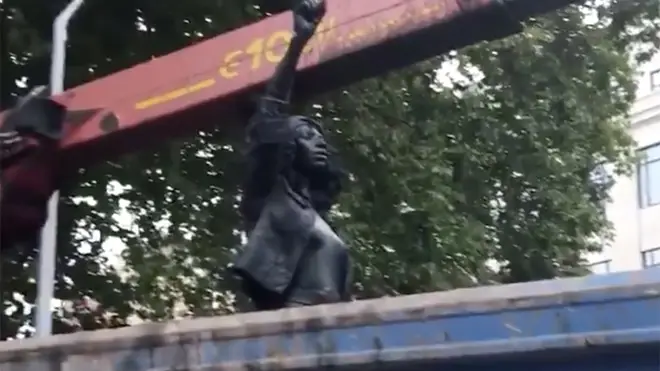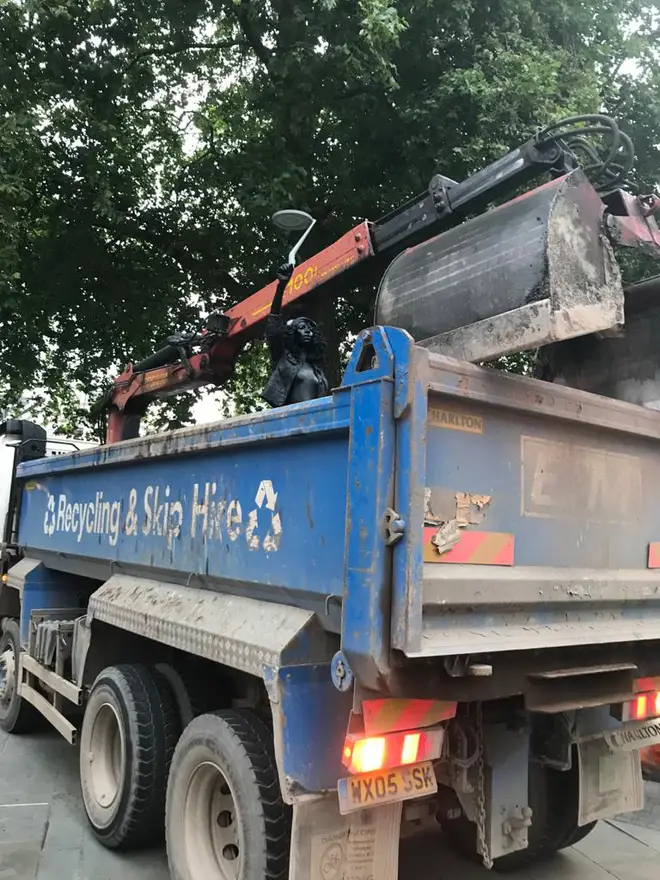
Clive Bull 1am - 4am
16 July 2020, 06:45

A statue of a Black Lives Matter protester that was installed on a plinth in Bristol where a statue of slave trader Edward Colston once stood was removed by workmen this morning.
Pictures from the scene early today show orkers at the site at around 5.20am on Thursday loading the sculpture into the back of a skip lorry.
Bristol council later tweeted to confirm they had removed the statue and it will be kept in a museum for the artist to collect, or donate to their collection.
READ MORE: Black Lives Matter statue installed on slave trader statue's plinth in Bristol
Artist Marc Quinn created the life-size black resin and steel piece of Bristol's Jen Reid after seeing a photo of her standing on the empty plinth following the toppling of the Colston statue.

The sculpture, entitled A Surge of Power (Jen Reid), was installed shortly before 4.30am on Wednesday by Mr Quinn's team without the knowledge or consent of Bristol City Council.
After the sculpture was installed, Mrs Reid stood in front of it with her fist in the air."It's just incredible," she told the Guardian.
"This is going to continue the conversation. I can't see it coming down in a hurry."
Marvin Rees, Mayor of Bristol said: "My relentless commitment is to build a city for all Bristiolians, with all our differences.
"To this end, the future of the plinth and what is installed on it must be decided by the people of Bristol.
"This will be critical to building a city that is home to those who are elated at the statue being pulled down, those who sympathise with its removal but are dismayed at how it happened and those who feel that in its removal, they've lost a piece of the Bristol they know and therefore themselves.
"We need change. In leading that change we have to find a pace that brings people with us. There is an African proverb that says if you want to go fast, go alone, if you want to go far, go together. Our challenge is to take the city far. The art of building our city will be finding a way to live with our difference so that even where people do not get what they want, they know they live in a city that is their one and respects them.
"The sculpture that has been installed today was the work and decision of London based artist. It was not requested and permission was not given for it to be installed.
"We have set out a process to manage our journey. We have established a history commission which help us tell our full city history
"As we learn this fuller history including the part played by black people, women, the working class, trade unions, and children among others, we will be in a better position to understand who we are, how we got here and who we wish to honour.
"Crucial to our heritage has been the harbour and the docks, manufacturing and industry, research and innovation, transport, slum clearances, housing, modern gentrification and faith.
"As the commission shares this information, the city will decide on city memorials and the future of the plinth."
On June 7, protesters used ropes to pull the Colston statue from its plinth in Bristol city centre.
It was thrown into Bristol Harbour near Pero's Bridge - named in honour of enslaved man Pero Jones who lived and died in the city.
On June 11 Bristol City Council retrieved the statue from the water and will display it in a museum along with placards from the Black Lives Matter protest.
The artist said the new sculpture has been installed in a way that made it "extremely difficult to move".